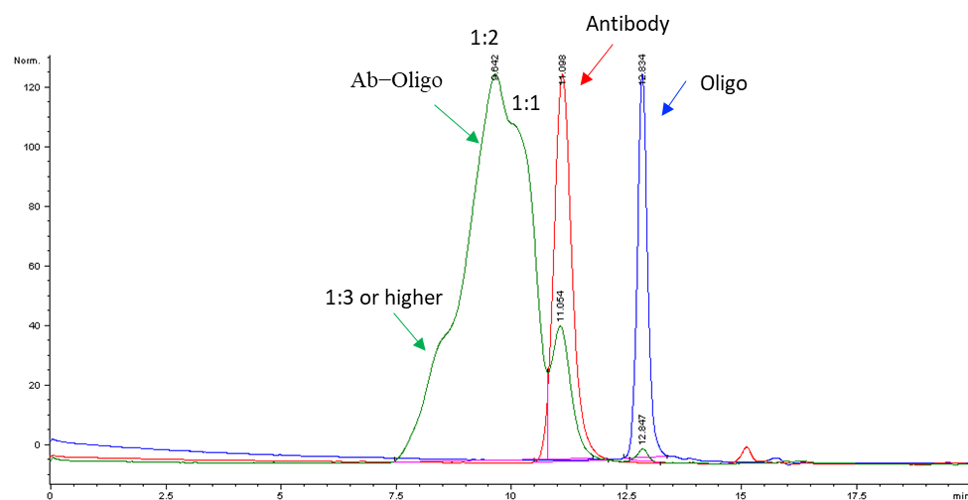Product Description
| Download Documents | |
| SDS | USER MANUAL |
CellMosaic® has designed this personalized antibody-oligo conjugation kit to work with any antibody and an amine-modified oligo. The user supplies their own antibody and amine-modified oligo (preferably a C6 amino modified oligo), which is readily available from many commercial oligo suppliers. Using the kit components, the user converts the amine-oligo to a maleimide-oligo (Step 1A in Scheme 1). Next, the user converts some of the surface amines of the antibody to free thiol groups (Step 1B in Scheme 1) which are then reacted with the maleimide-modified oligo to generate the conjugates (Step 2 in Scheme 1). If there are any unreacted thiols on the antibody, they are subsequently capped (Step 3 in Scheme 1). The final conjugate is then desalted and buffer exchanged with PBS buffer.
This kit provides materials to perform one or three antibody oligo conjugations. Scale of the reaction: 0.25-1 mg antibody (protein content).
Note to previous users: If you purchased this kit previously, the current one is an upgraded and improved kit with slightly different components and workflow as the first and second-generation kit. This kit has multiple configurations for various lengths of oligos and can be used to conjugate 4−15 nano-mole (nmol) of oligo. Table 1 provides the catalog numbers for various kit configurations.
Table 1: Configurations of the PerKit® Antibody-Oligo conjugation kit (CM53405)
|
Configuration |
No. of Reactions |
Catalog No. |
|
1. Labeling for short oligo (5−30 bases) |
1 |
CM53405.1x1 |
|
3 |
CM53405.1x3 |
|
|
2. Labeling for medium oligo (31−59 bases) |
1 |
CM53405.2x1 |
|
3 |
CM53405.2x3 |
|
|
3. Labeling for long oligo (≥60 bases) |
1 |
CM53405.3x1 |
|
3 |
CM53405.3x3 |
Requirement for antibody:
- Amount: 0.25-1 mg IgG needed per reaction
- Preferably >90% pure by gel electrophoresis
Requirement for amine-oligo:
- Amount: 4-15 nmol oligo content as measured by UV
- HPLC purified with amino-oligo content ≥90% by C18 HPLC.
- ≥5-mer. (oligos longer than 60-mer may result in lower loading and high impurities)
Note: You can purchase HPLC purified C6 amino-modified oligo from standard oligo manufacturers up to 90-mer length for this kit preparation. It is highly recommended that customers analyze and quantify oligos prior to using them.
Key Features of this Antibody-Oligo Conjugation Kit:
-
Offers a convenient way to prepare antibody−oligo conjugate with heterobifunctional crosslinking reagents
- Optimized precise loading with an average two oligos per antibody for high performance
-
Preparation can be done in a day (less than 8 hours) with various break points
- ≥90% conjugate if the quality of the oligo meets above standards
-
All reagents and supplies included for preparation to purification
- Options to choose tailored services at CellMosaic® after conjugation
- You can choose to send your conjugates to CellMosaic® for HPLC analysis of the sample or complete removal of trace oligo impurities and unreacted antibody.
Scheme 1: Synthetic route to antibody−oligo conjugate

Typical Kit Performance Data (LC analysis, CellMosaic®)
Antibody information: A therapeutic antibody (human IgG1 subtype)
Oligo information: HPLC-purified 18mer oligo with 5’ NH2-C6 modification
Kit lot number: S331.S9.040721
Scale of the reaction: 1 mg of antibody
Specification of the final conjugates:
Calculated average DOL: 1.9 Unreacted antibodies: 9.3%
Unreacted oligo: ~0.5% Conjugate Purity: >90% (85% recovery)
Figure 1: Size-exclusion chromatography (SEC) HPLC analysis of the unlabled antibody (Ab) (red trace), oligo (blue trace), and purified antibody-oligo (ab-oligo) conjugates (green trace).

Frequently Asked Questions:
The list below includes FAQs that are specific to this product.
Question: Is it possible to conjugate double-stranded DNA in which only one strand is aminated?
Answer: Yes, you will be able to use this conjugation kit for double-stranded DNA. For dsDNA >30 bp we recommend using the configuration for labeling long oligo: >60 bases (CM53405.3x1 for 1 reaction and CM53405.3x3 for 3 reaction). Depending on the melting temperature of your dsDNA, some single-stranded DNA may be present in the reaction mixture during step 1A (B6) but it should anneal back during purification (steps E1-E7).
Question: Did you internally test the conjugation efficiency for different hosts and isotypes?
Answer: We use hIgG1 for testing the antibody-oligo conjugation efficiency of our kit. As the labeling site on the antibody is at the surface amines, we do not expect too much variation in the conjugation efficiency for isotypes or antibodies produced from different hosts. We have performed some custom antibody-oligo synthesis with other isotypes of the antibodies for customers previously and have not seen too much of a difference with this chemistry. However, you may see some variation if your oligo is not pure enough or the oligo is too long and hydrophobic.
Question: What is the salt concentration of your conjugating buffer (Buffer B)? Our antibody is very sensitive to salt concentration.
Answer: Unfortunately, we are not able provide the exact salt concentration other than to mention that the salt concentration in Buffer B is <100 mM. The salt concentration has been optimized to balance out the labeling activity and the stability of the antibody.
Question: Does this kit generate stable or releasable conjugates? What is the expected method for payload release?
Answer: The CM53405 kit will generate antibody-oligo conjugate via a stable thiol ether bond. Once inside the cell, the antibody can be digested by protease enzymes, and the oligo is released with one amino acid at the end. If you need a release linker, such as VC-PAB, we can make it via our custom conjugation service. We have not yet developed a kit for such a configuration (Answered on Jan 16, 2023).
If you can’t find the answer you’re looking for or need information on general topics, please visit the main Frequently Asked Questions (FAQs) section.










